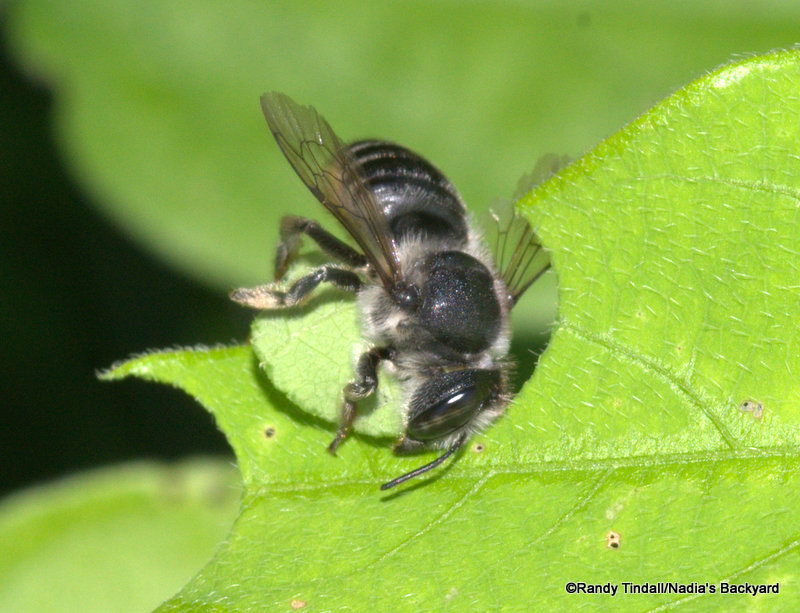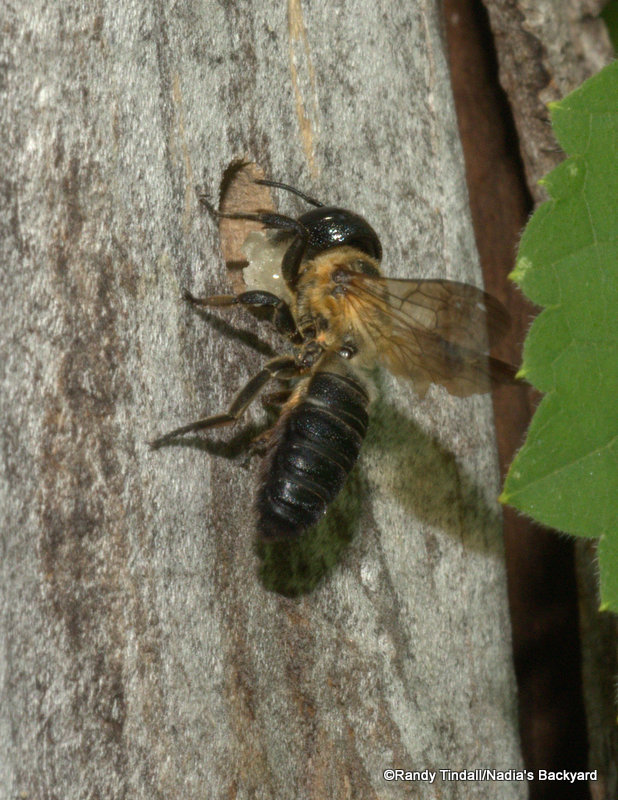Life travels, and a lot of it has made the journey to our backyard. That includes Nadia and me–a few hundred miles from my point of origin for me and considerably more for Nadia. Some of this life travels north to south and back each year and passes through on the way to grace us with its presence for a time, and some has meandered here haphazardly from far-off climes in all directions, welcome or not. Some of it stays here pretty much all the time, but all of it has journeyed through vast distances of time and evolution, those other dimensions of change that we can only peruse indirectly and with awe.
Our last post described such a traveler: a Leaf-cutter Bee, Megachile mendica, plying its trade and reproducing in our yard.
Now this particular specimen probably didn’t travel far to get here, since both of these species are native to Missouri, but a little research led to the discovery of some immense journeying indeed. Back into the mists of time. Way off yonder to a continent that split apart long, long ago. To a time and place where huge reptiles made the earth tremble and plants were just learning how to make flowers.
It is thought that bees originated around 125-150 million years ago in Cretaceous times, splitting off from wasps and chasing the promise of the rise of angiosperms, the flowering plants (“Let’s hustle, guys! New niche! Snooze and lose!”) and in turn fueling the rapid spread and diversification of these new and wondrous plants. This event probably happened on the fabled continent of Gondwana, before it separated into the South American and African continental plates, and it left the world a very changed place.

Old Gondwanaland and Laurasia (From U.S. Geological Survey)
The group that eventually gave us our leaf-cutter seems to have been one of the earlier bee groups to develop—the Megachilidae, an event which some researchers believe happened about 126 million years ago (making the case for an earlier origin for bees proper than was originally thought). But it was still quite a hike to get from down yonder in old Gondwana to our Missouri backyard. How did they do it? Possibly by developing the very behavior that they are named for—cutting leaves. It seems that bees have been making nests and laying eggs in them for a very long time, but bees that simply dig holes, lay eggs and provision them tend to be restricted to areas where moisture is not a problem. Exposure to moist conditions can result in microbes and fungi infecting the eggs, larvae and provisions, killing the young bees or reducing their chances of survival. The meant that the safest places to reproduce were in very arid deserts with little chance of rainfall during breeding season.
But then, somewhere along the line, some bright bees came up with the strategy of lining their nests to protect their contents. Some used Dufour’s gland to coat the nest and/or its contents with antimicrobial and antifungal secretions and some got the bright idea of using foreign materials, such as mud, plant resins or, like our little friend, leaves (fossil evidence for that here). They were off to the races after that: vast new areas were opened up for colonization by these clever pioneers, who could now waterproof their nests and guard against organisms that would attack them. It was time to see the world! Wherever flowering plants spread, the bees followed in a symbiotic frolic that we enjoy watching daily in our own yard, sitting outside our own lined cells (3 bedrooms, 2 1/2 baths, etc.).
Fellow travelers, all of us. And now our Leaf-cutter Bee has been joined by another immigrant–a Giant Resin Bee (Megachile sculpturalis) that has made the trip from Asia relatively recently, first being reported in this country from North Carolina in 1994. This large interloper uses plant resins to line and seal its nests, instead of rolling segmented cigars to lay eggs in. The result is the same. The kids are snug as bugs in rugs.
There is one more twist in this story. Bees had something in common with the dinosaurs, being present when a comet or asteroid bumped into what is now the Gulf of Mexico, resulting in the Cretaceous Extinction that wiped out maybe 75% of all the world’s species (but also see here). Fortunately, some bees, some flowering plants and at least one shy little mammal squeaked through, unlike the non-avian dinosaurs which soon thundered no more across the landscape. If they hadn’t our world would be a vastly different place.
Descendants of all of them, echoes of cosmic events and epic history, now share our backyard, carrying on as best we can, journeying on to wherever and whatever is ahead, all connected forward and back.
Life travels.




Great post! Species development and extinction have been on my mind of late. Interesting info about the Giant Resin Bee. Thanks!
Thanks! Always something going on here. I appreciate your reading and comments.